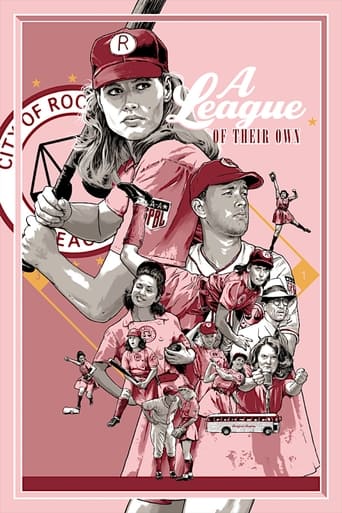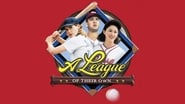kols
Finally, after 20+ years, I recorded and watched what I thought was going to be a middling Tom Hanks comedy. Reason for that was the trailers I'd seen hundreds of times: "Crying. There's no crying in baseball!"What I saw was a movie that should have been allowed to give Unforgiven serious competition for Best Picture and Geena Davis an Oscar for Best Actress in a leading role. Apparently I wasn't the only one fooled by those trailers.Penny Marshall's movie is a brilliant, beautifully crafted homage to a little remembered period when, just as Rosie became a riveter, numbers of talented women filled in for their men as ball players. Proving, like Rosie, they were every bit as capable as the absent males.More than that, of course, is the broader theme of the individual refusing to buckle under to social conventions. A very common American theme with Marshall's contribution ranking with the best of its expositions. Pretty good as a Baseball pic, too.It is a long movie, over 2 hours, but, despite the simplicity of the story, it doesn't play like two hours. From the first scene you (or at least I) fall in love with the screen and time becomes meaningless.Two people, supported by a strong supporting cast, are responsible: Peggy Marshall and Geena Davis. Marshall and her editor crafted a truly remarkable piece of cinematography that may be perfect; not a clang or misstep anywhere.Such movies need glue to make it all hang together and that's where Davis comes in: though brilliantly supported, without Davis the whole house would have failed. League is very much Geena Davis' movie, she's the one who puts flesh to the bones of Penny Marshall's vision.As Americans we love and should love movies like this, these celebrations of the best of our values, of how hundreds of women kept a league of their own alive for ten years.That achievement was quickly forgotten, buried in the reactionary conservatism of the '50s, which should anger us, but that anger can easily be tempered by Marshall's rediscovery and loving treatment of their story.For all of that seriousness, League is a successful comedy and fun to watch while, also successfully, demonstrating both how far we've come and how far yet to go.A large part of that 'yet to go' are those trailers that made me think that League was a Tom Hanks movie. It isn't; Hanks is almost a tertiary figure. Davis and the supporting cast, all women, are the Stars. Hanks character, Jimmy Dugan, is important and, especially at the last, honored but, as the movie unfolds, more comic relief than mover. Very much a second fiddle; to his credit, Hanks plays that fiddle masterfully.However, the fact that the distributors felt the need to exaggerate his presence to the point of ridiculousness speaks volumes about how, even in 1992, we weren't ready to embrace a movie by women about women. The Oscar's Nominating Committee's failure to recognize League as the masterpiece it is stamps paid to that point.As a movie, judged by objective cinematic standards, League should rank with the best of the best.
FilmBuff1994
A League of Their Own is a great movie with a very well developed storyline and a terrific cast. It's a very compelling drama with a lot of heart and very likable characters, I'm not sure how historically accurate it really is, but it feels very natural throughout. I felt like it needed more character development from characters outside of Dottie, of course she is the main character and we are going to learn the most about her, but some more development from Jimmy and several female characters would have helped the story progress. The film also has many funny parts, though it isn't purely a comedy, it has several bits that are there for a chuckle and I appreciated this, it dosen't take itself too seriously. A compelling movie with a strong cast, I would recommend A League of Their Own to anyone looking for a good drama or sports film. Two sisters become rivals when they join the first female professional baseball league during World War II. Best Performance: Geena Davis Worst Performance: Madonna
SimonJack
"A League of Their Own" is an enjoyable film about the short stint that women's professional baseball had in the U.S. From 1943 to 1954, there was a professional league that was the brainchild of Chicago chewing gum magnate Philip Wrigley. He and other baseball owners started the league supposedly to keep baseball "alive" in the minds of the public during World War II. The thinking was that the sport might die out because so many men who played professional baseball went off to war. The women's league went through a few name changes. In 1943, the All- American Girls Softball League was changed to the All-American Girls Baseball League. The league ranged from four to 10 teams each year and had a total of 15 teams over its 12-year history. It started with four teams, two of which are portrayed playing the first girls baseball world series in 1943 – the Racine Belles and the Rockford Peaches. The movie is a highly fictionalized story of the founding and first year of the league. But it includes a reunion of many of the girls at the National Baseball Hall of Fame when its Women in Baseball exhibit opened on Nov. 5, 1988. Penny Marshal who produced and directed the movie, attended that opening and shot scenes there. The lead character, Dottie Hinson (played by Geena Davis) was said to be a composite of two of the real girl players – Dottie Kamenshek and Pepper Paire Davis. In the movie, Dottie is married and plays just one year until her wounded husband returns from the war. The real Kamenshek, however, began playing when she was 17 and never married. She was considered the best player of the league and led her team, the Rockford Peaches, to four of the 12 series titles. She led the league in many stats. All the rest of the characters in the film were fictional as well, as was the Peaches' manager, Jimmy Dugan, played by Tom Hanks. I suppose Hollywood thought a straight story based mostly on facts and real characters wouldn't be as glamorous or interesting. There's no doubt that Hanks' Jimmy Dugan added some color to the film. But the film does give an accurate portrayal of the training the girls were required to take – off the field. They studied etiquette and manners. And it is a good account of the uniforms and other aspects of the girls professional baseball. The girls teams played mostly at larger towns outside of the major league cities. That also makes the supposed purpose of the league – to keep baseball alive in the minds of the public – suspect. After all, the big leagues (National and American) continued to play ball all during the war. They did suspend play for a couple days after the bombing of Pearl Harbor. But the game went on and each year the World Series games were played at the end of the regular season. For the record, the St Louis Cardinals won the 1942 World Series over the NY Yankees. The Yankees turned the trick the next year against the Cards. Then, the Cards won the 1944 Series over cross-town rivals, the St. Louis Browns. Finally, in 1945 the Detroit Tigers took the Series over the Chicago Cubs. I mention this because a scene sticks in my mind from the 1943 movie, "Guadalcanal Diary." William Bendix is a corporal who's listening to a game on the radio and rooting for the Brooklyn Dodgers. There's some talk among the men about the possibility of the Dodgers winning the pennant to play the Yankees in the World Series. That probably was the year of the movie – 1943. The Dodgers finished third that year in the National League, behind Cincinnati and far behind the Cards. Still, one wonders if there might not have been one or more other reasons behind the women's pro baseball league. For starters, how about another venue of wholesome and interesting entertainment for folks back home during the war? Especially since the folks outside the cities didn't often get to see big league games. Remember – this is before television. Then there's always the profit motive. One scene in the film addresses this. The Walter Harvey character (of chewing gum fame – guess who) played by Garry Marshall tells Ira Lowenstein, the league manager, played by David Strathairn, that the league will have to shut down after the first year because it's losing money. Of course, Ira does some things to turn that around, with the help of some of the players. The movie completely dodges one aspect of the girls pro baseball league. That has to do with sizes and distances. The ball they used to start with was the same size as a softball – 12 inches in circumference (compared to the 9-inch baseball). And they pitched it underhanded. The infield was considerably smaller than that of pro baseball. The distance between bases was 65 feet, compared to 90 in baseball. The pitcher's mound was 40 feet from home plate, compared to 60 feet, six inches. As the years went on after the war, the field distances widened and got closer to those of baseball, and by 1948, the ball size was 10 3/8 inches and overhand pitching was allowed. This is an enjoyable film to watch and a nice tribute to women's baseball and sports in general. For more history and an accurate account of the girls pro baseball league, one might visit the Baseball Hall of Fame and Museum at Cooperstown, NY.
Sean Lamberger
Geena Davis helms a plucky, extroverted squad of girls embroiled in the inaugural season of a ladies' baseball league. It's got heart and charm to spare, but often veers too close to super motivational, Lifetime Network feel-good material for my taste. The talent is there, with strong support from Tom Hanks, Jon Lovitz and Madonna, though their roles frequently edge near the cartoonish. Some are able to pull that off - Lovitz has been making bread with such exaggerated characters for years - but others, like Rosie O'Donnell's stereotypical feisty Jersey girl, aren't as adept. Puffy, padded, and egregiously predictable, its message about the irresistible force of gender equality in the midst of WWII is nice, but often feels secondary to the manufactured lite drama in the locker room.



 AD
AD











